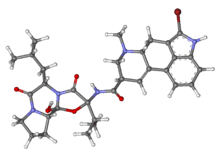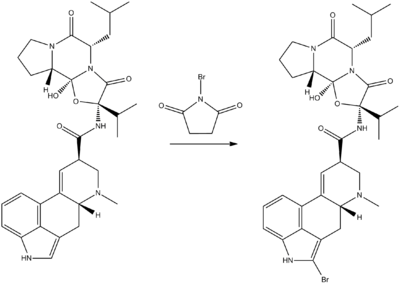Bromocriptine
 | |
 | |
| Clinical data | |
|---|---|
| Trade names | Parlodel, Brotin |
| AHFS/Drugs.com | Monograph,International Drug Names |
| MedlinePlus | a682079 |
| Pregnancy category | |
| Routes of administration | oral, intravenous |
| ATC code | G02CB01 (WHO) N04BC01 (WHO) |
| Legal status | |
| Legal status | |
| Pharmacokinetic data | |
| Bioavailability | 28% of oral dose absorbed |
| Metabolism | Extensively liver-mediated |
| Biological half-life | 12-14 hours |
| Excretion | 85% bile (faeces), 2.5-5.5% urine |
| Identifiers | |
| |
| Synonyms | 2-Bromoergocriptine |
| CAS Number |
25614-03-3 |
| PubChem (CID) | 31101 |
| IUPHAR/BPS | 35 |
| DrugBank |
DB01200 |
| ChemSpider |
28858 |
| UNII |
3A64E3G5ZO |
| KEGG |
D03165 |
| ChEBI |
CHEBI:3181 |
| ChEMBL |
CHEMBL493 |
| ECHA InfoCard | 100.042.829 |
| Chemical and physical data | |
| Formula | C32H40BrN5O5 |
| Molar mass | 654.595 g/mol |
| 3D model (Jmol) | Interactive image |
| |
| |
| (verify) | |
Bromocriptine (INN; trade names Parlodel, Cycloset, Brotin (Pakistan)), an ergoline derivative, is a dopamine agonist that is used in the treatment of pituitary tumors, Parkinson's disease (PD), hyperprolactinaemia, neuroleptic malignant syndrome, and type 2 diabetes.
Indications
Amenorrhea, female infertility, galactorrhea, hypogonadism, and acromegaly may all be caused by pituitary problems, such as hyperprolactinaemia, and therefore, these problems may be treated with this drug. Bromocriptine has completely treated gestational macromastia eliminating the need for reduction surgery, in a recent case.[1] It has also been used in treating nonpuerperal mastitis.[2] Since the late 1980s it has been used, off-label, to reduce the symptoms of cocaine withdrawal.[3][4] In 2009, bromocriptine mesylate was approved by the FDA for treatment of type 2 diabetes under the trade name Cycloset (VeroScience). It is currently unknown how this drug improves glycemic control, but it has been shown to reduce HbA1c by ~0.5 percentage points.[5]
Pharmacology
Bromocriptine is a potent agonist at dopamine D2 receptors[6] and various serotonin receptors. It also inhibits the release of glutamate, by reversing the glutamate GLT1 transporter.[7]
Bromocriptine agonizes the following monoamine receptors:[8]
- Dopamine D1 family
- Dopamine D2 family
- Serotonin 5-HT
- Adrenergic α family
- Adrenergic β family
Side effects
Most frequent side effects are nausea, orthostatic hypotension, headaches, and vomiting through stimulation of the brainstem vomiting centre.[9] Vasospasms with serious consequences such as myocardial infarction and stroke that have been reported in connection with the puerperium, appear to be extremely rare events.[10] Peripheral vasospasm (of the fingers or toes) can cause Raynaud's Phenomenon. Bromocriptine use has been anecdotally associated with causing or worsening psychotic symptoms (its mechanism is in opposition of most antipsychotics, whose mechanisms generally block dopamine).[11] Pulmonary fibrosis has been reported when bromocriptine was used in high doses for the treatment of Parkinson's disease.[12]
Use to suppress milk production after childbirth was reviewed in 2014 and it was concluded that in this context a causal association with serious cardiovascular, neurological or psychiatric events could not be excluded with an overall incidence rate estimated to range between 0.005% and 0.04%. Additional safety precautions and stricter prescribing rules were suggested based on the data.[13][14] Bile salt export pump inhibitor.[15]
Chemistry
Like all ergopeptides, bromocriptine is a cyclol; two peptide groups of its tripeptide moiety are crosslinked, forming the >N-C(OH)< juncture between the two rings with the amide functionality.
Bromocriptine is a semisynthetic derivative of a natural ergot alkaloid, ergocryptine (a derivative of lysergic acid), which is synthesized by bromination of ergocryptine using N-bromosuccinimide.[16][17]

See also
References
- ↑ Ezem, B. U.; Osuagwu, C. C.; Opara, K. A. (2011). "Gestational gigantomastia with complete resolution in a Nigerian woman". Case Reports. 2011: bcr0120102632. doi:10.1136/bcr.01.2010.2632. PMC 3062818
 . PMID 22707463.
. PMID 22707463. - ↑ Goepel E, Pahnke VG (1991). "Successful therapy of nonpuerperal mastitis – already routine or still a rarity?". Geburtshilfe Frauenheilkd (in German). 51 (2): 109–16. doi:10.1055/s-2007-1023685. PMID 2040409.
- ↑ Giannini, A. James; Baumgartel, Peter; DiMarzio, Lynn R. (1987). "Bromocriptine Therapy in Cocaine Withdrawal". The Journal of Clinical Pharmacology. 27 (4): 267–70. doi:10.1002/j.1552-4604.1987.tb03011.x. PMID 3316308.
- ↑ Tennant, Forest S. (1987). "Double-blind Comparison of Amantadine and Bromocriptine for Ambulatory Withdrawal From Cocaine Dependence". Archives of Internal Medicine. 147 (1): 109–12. doi:10.1001/archinte.1987.00370010109025. PMID 3541819.
- ↑ Pijl, H.; Ohashi, S.; Matsuda, M.; Miyazaki, Y.; Mahankali, A.; Kumar, V.; Pipek, R.; Iozzo, P.; Lancaster, J. L.; Cincotta, A. H.; DeFronzo, R. A. (2000). "Bromocriptine: a novel approach to the treatment of type 2 diabetes". Diabetes Care. 23 (8): 1154–61. doi:10.2337/diacare.23.8.1154. PMID 10937514.
- ↑ De Leeuw Van Weenen, J. E.; Parlevliet, E. T.; Maechler, P.; Havekes, L. M.; Romijn, J. A.; Ouwens, D. M.; Pijl, H.; Guigas, B. (2010). "The dopamine receptor D2 agonist bromocriptine inhibits glucose-stimulated insulin secretion by direct activation of the α2-adrenergic receptors in beta cells". Biochemical Pharmacology. 79 (12): 1827–36. doi:10.1016/j.bcp.2010.01.029. PMID 20138024.
- ↑ Shirasaki, Y; Sugimura, M; Sato, T (September 2010). "Bromocriptine, an ergot alkaloid, inhibits excitatory amino acid release mediated by glutamate transporter reversal.". European Journal of Pharmacology. 643 (1): 48–57. doi:10.1016/j.ejphar.2010.06.007. PMID 20599932.
- ↑ National Institute ofMental Health. PDSD Ki Database (Internet) [cited 2013 Jul 24]. ChapelHill (NC): University of North Carolina. 1998-2013. Available from: "Archived copy". Archived from the original on 2013-11-08. Retrieved 2013-11-26.
- ↑ Weil, C. (1986). "The safety of bromocriptine in long-term use: a review of the literature". Current medical research and opinion. 10 (1): 25–51. doi:10.1185/03007998609111089. PMID 3516579.
- ↑ Iffy, L; McArdle, JJ; Ganesh, V; Hopp, L (1996). "Bromocriptine related atypical vascular accidents postpartum identified through medicolegal reviews". Medicine and law. 15 (1): 127–34. PMID 8691994.
- ↑ Boyd, A. (1995). "Bromocriptine and psychosis: a literature review". The Psychiatric quarterly. 66 (1): 87–95. doi:10.1007/BF02238717. PMID 7701022.
- ↑ Todman, D.; Oliver, W.; Edwards, R. (1990). "Pleuropulmonary fibrosis due to bromocriptine treatment for Parkinson's disease". Clinical and experimental neurology. 27: 79–82. PMID 2129961.
- ↑ EMA Statement "CMDh endorses restricted use of bromocriptine for stopping breast milk production"
- ↑ http://m.aerzteblatt.de/news/59857.htm "EMA rät vom Abstillmittel Bromocriptin ab", article in Ärzteblatt
- ↑ Montanari, Floriane; Pinto, Marta; Khunweeraphong, Narakorn; Wlcek, Katrin; Sohail, M. Imran; Noeske, Tobias; Boyer, Scott; Chiba, Peter; Stieger, Bruno; Kuchler, Karl; Ecker, Gerhard F. (2016). "Flagging Drugs That Inhibit the Bile Salt Export Pump". Molecular Pharmaceutics. 13 (1): 163–71. doi:10.1021/acs.molpharmaceut.5b00594. PMID 26642869.
- ↑ E. Fluckiger, A. Hofmann, U.S. Patent 3,752,814 (1973)
- ↑ A. Hofmann, E. Flueckiger, DE 1926045 (1969)
External links
- www.AcromegalyCommunity.com: Emotional and communal support for those touched by Acromegaly- page discussing drug, side effects, and prescription programs
- MedlinePlus DrugInfo medmaster-a682079
- http://www.drugs.com/pro/bromocriptine.html